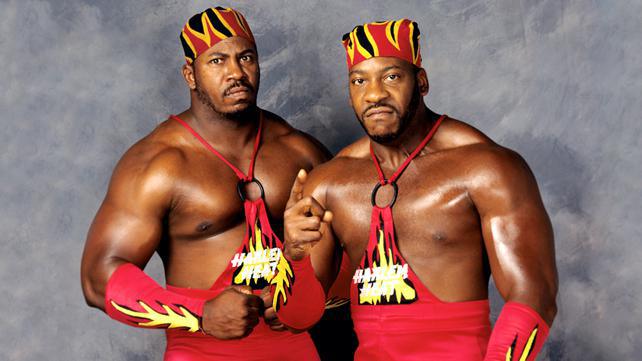Subscribe to the podcast via: iTunes | Spotify | Google | Youtube
I often hear about the "state" of tag team wrestling in 2015, people hark back to the old days and imply that the death of two on two combat is a relatively modern phenomena. OK, many people hark back to the days of the Legion of Doom and the Road Warriors, but in to the mid-90s wasn't really much of an improvement on anything we have now.
In the WWF it was an odd time for tag teams. As we picked up the project in the middle of 1993 we had probably two of the best tag teams in The Steiner Brothers and The Quebecers. Sean Waltman tweeted me a year or so ago calling The Quebecers one of the "last great bookend tag teams" (teams that look/dress alike).
As with a lot of discussions on the "strength" of a tag team division often it seems that if the guys at the top of the pile are doing it then people will call a tag division "strong" regardless of what's beneath. Remember Beer Money vs The Motor City Machine Guns in TNA? That great series of matches was an underlying point in the "great state" of tag wrestling not only in TNA but in America itself. Not that it was easy to follow, but part of the problem was that TNA didn't really have another team they could throw into that mix.
In the WWF it was sort of similar: the Quebecers split up, The Steiners left and we ended up with teams like The 123 Kid & Marty Jannetty, Shawn Michaels and Diesel & Yokozuna and Crush competing for the belts. WWF had more genuine tag teams around at the time: The Headshrinkers, The Bushwhackers, "Well Dunn", The Smoking Gunns and others - but these were all lower card guys, really.
Things were meandering in WCW too. Most teams were put together: Too Cold Scorpio and Marcus Alexander Bagwell, Paul Orndorff and Paul Roma as “Pretty Wonderful”, the highly entertaining team of Maxx Payne and Cactus Jack, Bagwell again alongside The Patriot as “Stars and Stripes”. Make no mistake, in part, this wasn't like now in the sense that the tag champions weren't losing on TV every week – but whether the talent in the mid-90s was stronger than it is now I would contend with.
Fortunately for followers of this project there were a few rays of light. Two men in WCW debuted in late 1993 as “Cain and Cole”. Originally they were slated to play an incredibly racist gimmick of two slave/prisoners under the control of Col Robert Parker. Fortunately that never saw the light of day and the two would be thrust straight into the main event at Fall Brawl. Don't remember “Cain and Cole”? It would probably help if I told you they were repackaged as “Harlem Heat” - Booker T and Stevie Ray.
In ECW there is only one place to look – and that is at The Public Enemy. Paul Heyman put together the team of Flyboy Rocco Rock and Johnny Grunge, a pair of Philly street thugs who perfectly represented what Heyman's vision of ECW was and would become. While guys like Terry Funk and Shane Douglas would be the men charged with setting the standard in the company, it was the Public Enemy that were the real epitome of what ECW were about. In a weird way, it's a testimony for how it all came together that the team couldn't find success outside of ECW.
But perhaps the most surprisingly bright spark in mid-90s tag teams comes from the most unlikeliest of sources. The Nasty Boys weren't great wrestlers, they weren't great talkers – they weren't really great at anything. But something just came together for the duo in 1994. First it was the face-off against Cactus Jack (and Maxx Payne/Kevin Sullivan) in the first half of the year. Both teams competed in what, by any standards, would be viewed as really, really good tag-team brawls. Put it into 1994 and you get something revolutionary – something that probably predates that style of match in ECW too.
While that would be the zenith (and unfortunate change of policy by higher ups in WCW/Time Warner meant the violent style of match would disappear as Spring became Summer). But a face turn thrust The Nasties back into the spotlight – headlining Fall Brawl 1994 in the War Games match alongside Dustin and Dusty Rhodes.
You'd have to look quite hard for tag team gold in the mid-90s (in the WWF you'd be lucky if you found it at all), but the standard then was a lot like it is now: there were no great teams but those given the opportunity to (cliché alert) accentuate their strengths and hide their weaknesses were capable of proving their worth. Find any Public Enemy promo from 1994, or either of the Nasty Boys matches from Spring Stampede or Slamboree 1994 – you won't be disappointed.

 RSS Feed
RSS Feed